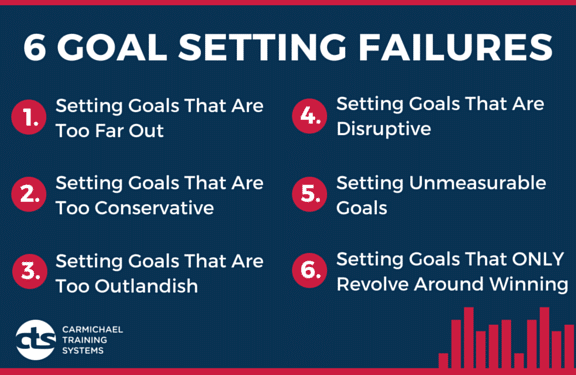
6 Goal Setting Failures That Could Ruin Next Season
By Noah Niwinski,
CTS Senior Coach
You would think setting goals would be one of the simpler components of being an athlete. What do you want to do? Why do you want to do it? What does success look like if you accomplish it?
But the truth is that many athletes are much better at stepping through a long series of workouts than they are at determining why they are training in the first place. When you are setting your athletic goals here are the top six ways you can screw up.
Error #1. Setting Goals That Are Too Far Out
There’s nothing wrong with long-range planning or setting a series of goals that cover a range of years. But the key to long-range goal setting is incorporating shorter-term goals you can check off the list.
Even for moderately trained endurance athletes, training for your first epic (i.e. SBT GRVL, Leadville 100 MTB or Run, an Ironman, etc.) is typically a 12-month process. Trying to hit a marker that far out is extremely hard unless you have some markers along the way that help you stay on target.
Set an ultimate goal for the year or even for some time within the next few years, but backfill your goal worksheet with process or competition goals every 3-4 months so there’s always a tangible goal within your reach.
Error #2. Setting Goals That Are Too Conservative
If you already did it last year, it’s not a challenging goal for this year. Many athletes compete or participate in the same events year after year. That’s great, but your goals around those events must change and progress.
The exception to that advice is when lifestyle changes have significantly changed your ability to train compared to last year. In that case, getting back to a previous performance level can be a legitimate and immensely challenging goal.
Successful goals push you outside your comfort zone. They scare you a bit because failure is a distinct possibility. It’s that desire to succeed in the face of a challenge that helps you commit to high-quality workouts, to training when the weather is bad, and to pushing yourself when you’re tired.
Error #3. Goals That Are Too Outlandish
Your goals should stretch your capacity, but they have to be within the realm of possibility. We’ve actually had a Cat 5 bike racer – without any hint of sarcasm – tell us his goal was to race the Tour de France within 18 months. There may be a talent out there who could accomplish that, but it wasn’t him.
► Free Cycling Training Assessment Quiz
Take our free 2-minute quiz to discover how effective your training is and get recommendations for how you can improve.
Ambitious goals are great because they demand great focus; you know you will only accomplish an ambitious goal if a lot of things go right. On the other hand, unrealistic goals quickly become farcical. You won’t be able to take them seriously, which means they won’t hold your attention.
Error #4. Goals That Are Too Disruptive
If your goals require a complete reboot of your life, they are probably not realistic. Now, there are certainly people who have ditched their jobs, walked away from their families, and sold their earthly possessions to pursue a goal that changes the world. With extremely rare exception, your sporting goal doesn’t qualify.
What’s more, the more disruptive your goals are to your life outside of sport, the less likely you’ll be able to stick to them. Minor disruptions – getting up earlier, going to bed earlier, some dietary changes, some long workouts some weekends – are pretty easy to accommodate and can be both necessary and good. Just be wary of changes that add lifestyle stress.
Error #5. Setting Unmeasurable Goals
Athletes often set vague goals when they lack confidence in their ability to achieve something – anything – specific. Rather than risk failure they establish unmeasurable goals like “doing better on the group ride” or “being a better climber.” Those goals can be made specific by establishing performance markers (time pulling at the front, staying in the front group on a climb, improving sustainable climbing power by 10%, etc.).
Better yet, set measurable goals that are achievable through training and nutrition: increased power over a specific duration, increased time you can sustain a specific power/pace, X% increase in VO2 max, etc. These measurable goals lead to improved performance capacity, which means reaching your goals in training puts you in a better position to succeed in real-world events.
Error #6. Setting Goals That ONLY Revolve Around Winning
We all love to win, but the reality of endurance competition is that even the best athletes lose a lot more often than they win. There are also so many variables involved in winning an endurance race that being the fastest, strongest, and even smartest athlete on the day doesn’t guarantee a victory. It’s good for some of your outcome goals to be related to results, but you should also set personal and meaningful goals you can achieve even if you don’t end up on top of the podium.
► FREE Mini-Course: Learn How to Maximize Your Limited Training Time
Learn step-by-step how to overcome limited training time and get faster. Walk away with a personalized plan to increase your performance.
"*" indicates required fields



Comments 8
I recently revamped my A+ rides for next year using some of your suggestions. thanks for the article.
There’s also nothing wrong with just riding. Or swimming. Or hiking. Or running, skiing, paddling…whatever. Even if you’ve won stuff before. Just having adventures and having fun is ok too.
Agree At 70 I’ve done it all and am just enjoying being out.
🙂
Excellent words for me to reflect on as I make my list of fitness goals for 2025!
Very relevant. I remember SMART now. It is not new but still very useful. A good read and a reminder of things I knew but had forgotten. This will be circulated to all the athletes in my group as a reminder of the things they had been told but had forgotten,
SMART
Specific: is targeted on an area of improvement;
Measurable: has clear success metrics assigned to it;
Achievable: can be broken down in realistic steps;
Relevant: fits inside the general scope and strategy of the project;
Time-bound: has a (realistic) deadline;
Very good advice 😊.
Thank You!!